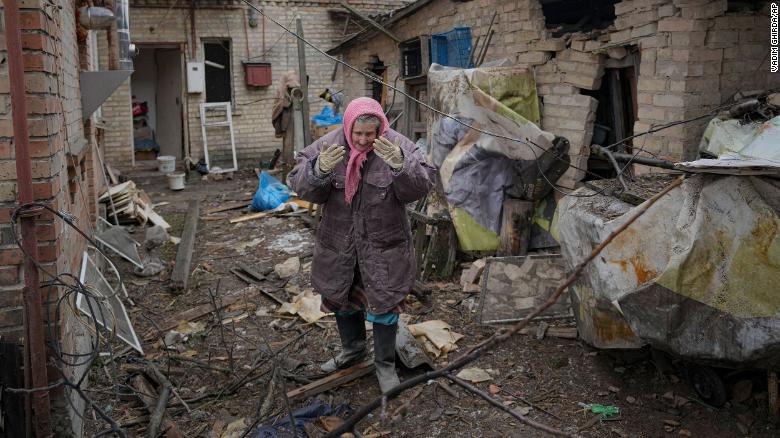These maps explain why Putin invades Ukraine 2:47
(CNN) --
Turn on Russian state television and the spectacle of the war in Ukraine is pretty bloodless.
News broadcasts show Russian troops on the move in Ukraine's eastern Donbas region, Russian military helicopters hover above tree level, and downcast Ukrainians lay down their arms and sign pledges not to fight.
Russian First Channel on Wednesday also featured commentators gathered around a fancy interactive map purporting to show the advances of Russian troops and Russian-backed separatist forces from the self-proclaimed Donetsk and Luhansk People's Republics.
Russia-Ukraine War: Breaking News and Negotiations and Invasion
What the Russians were not seeing, however, were images of Ukrainian cities like Kharkiv and Kyiv after heavy shelling or missile attacks.
A woman inspects the backyard of a house damaged by a Russian airstrike, according to locals, in Gorenka, near Kyiv, on Wednesday.
No, the picture on Russian television is largely sterile, with slick Defense Ministry video and stiff official reports from Russia's top military spokesman, Major General Igor Konashenkov.
There is little mention of casualties, whether Russian military or Ukrainian civilians, and the language is euphemistic.
Russia, after all, is carrying out what is called a "special military operation", and the national media is forbidden to call it a war or an invasion.
But a picture of Russia's military intentions is becoming clearer.
Around Kyiv, his forces are concentrating on surrounding the Ukrainian capital, in an apparent attempt to overthrow the government, a goal that President Vladimir Putin brazenly and falsely calls "denazification."
And a sort of crescent of Russian-controlled territory is emerging in the east and south of the country.
advertising
On Wednesday morning, Russia claimed its troops had taken full control of the southern city of Kherson, north of the Crimean peninsula, something Ukraine's Defense Ministry disputed.
Hours later, the mayor claimed that the Ukrainian forces were no longer in the city.
But the push north from Crimea has expanded a zone of Russian control that was established in 2014, when Russia occupied and annexed the Black Sea peninsula.
It also restored Crimea's water supply, as Russian forces reopened a canal that supplied up to 85% of the peninsula's needs before it was cut off following annexation.
ANALYSIS |
Opposition to Putin's war is alive and well in the streets of Moscow.
But Russian TV doesn't show it
More importantly, the advance in the area shows the beginning of a potential land bridge that could, in theory, link the Ukrainian port city of Odessa, via Kherson, with separatist-controlled territories to the east.
A key part of that potential corridor is the southeastern city of Mariupol.
Heavy fighting continues there, with Russian and Russian-backed separatist forces surrounding the city of some 400,000 people on three sides.
Ukrainian emergency service personnel carry the body of a victim after the shelling of the Regional State Administration building in Kharkiv on Tuesday.
Vadym Boychenko, the mayor of Mariupol, said on Wednesday that the number of injured civilians was "growing every day."
North of Mariupol, and close to the Russian border, the city of Kharkiv has been the target of intense Russian attacks.
On Wednesday, there was a military strike in the vicinity of the Kharkiv City Hall, a day after the building of the Kharkiv Regional State Administration was targeted in an attack that Ukrainian officials say killed 10 people and wounded at least 24. .
No images of this fight are reaching state television viewers in Russia, although many Russians have access to the Internet and some can watch international networks.
But the messages from Russian officials and state media are eerily reminiscent of the war in Syria.
The Kremlin has warned that Ukrainian "nationalists" plan to use civilians as "human shields", while the Russian military offers the promise of safe routes out of the city.
On the morning that Russia launched its invasion of Ukraine, Konashenkov, the Russian military spokesman, claimed, without evidence, that the Ukrainian Security Service was preparing to circulate false news about civilian casualties.
Russian Army military vehicles are seen in Armyansk, Crimea on Friday.
"Video shootings with alleged 'mass casualties' among the civilian population of Ukraine were carried out in Ukrainian cities," Konashenkov said, according to the Russian state news agency RIA-Novosti.
Such wild and unsubstantiated claims follow Russia's playbook of smearing Syria's White Helmets, a volunteer rescue group that has provided the world with some of the most convincing evidence of attacks on civilians by Syrian President Bashar al- Assad, backed by Russian airpower.
Russia insists that it is not aiming to attack Ukraine's residential neighborhoods, despite overwhelming evidence to the contrary.
But the deliberate repetition of such propaganda is a chilling reminder that the default Russian strategy, when it comes to evidence of civilian casualties, is outright denial.
Russian invasion of Ukraine

